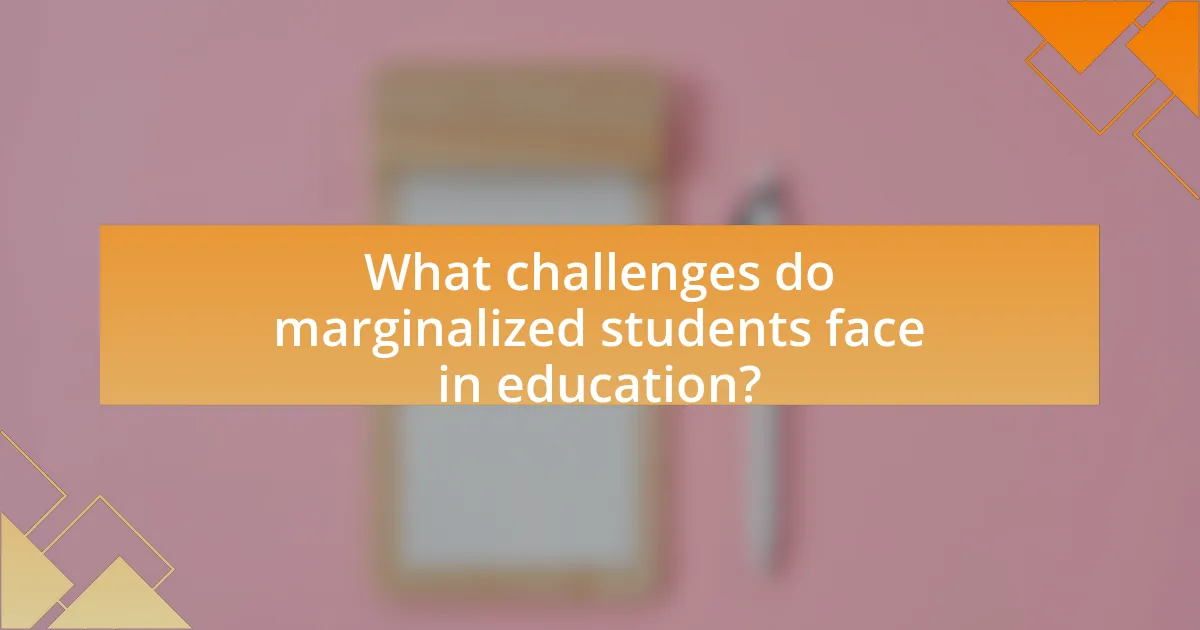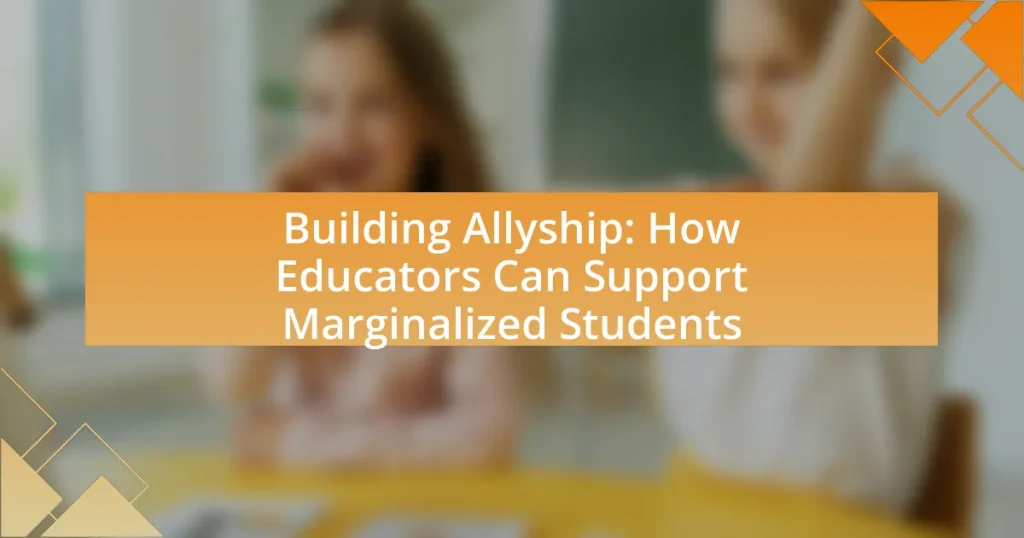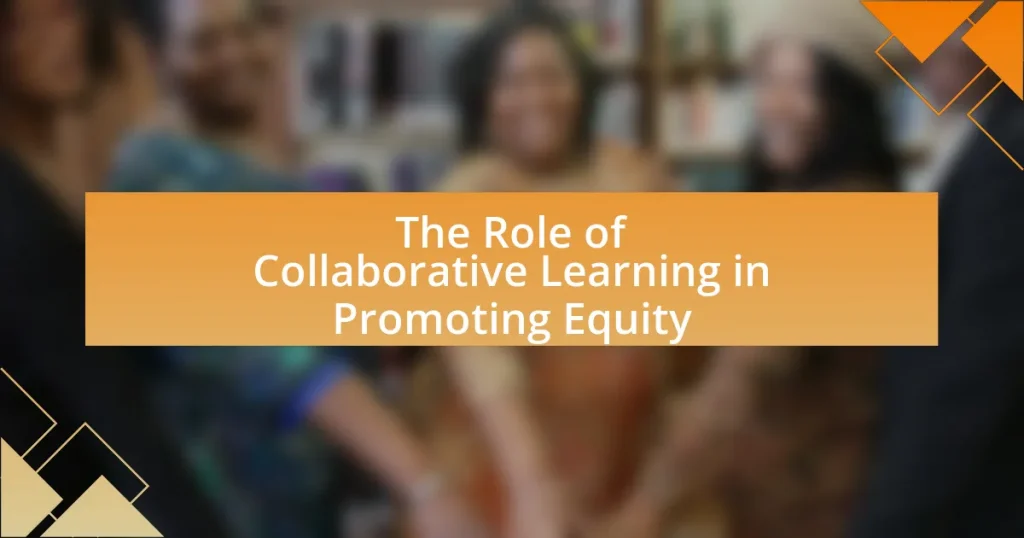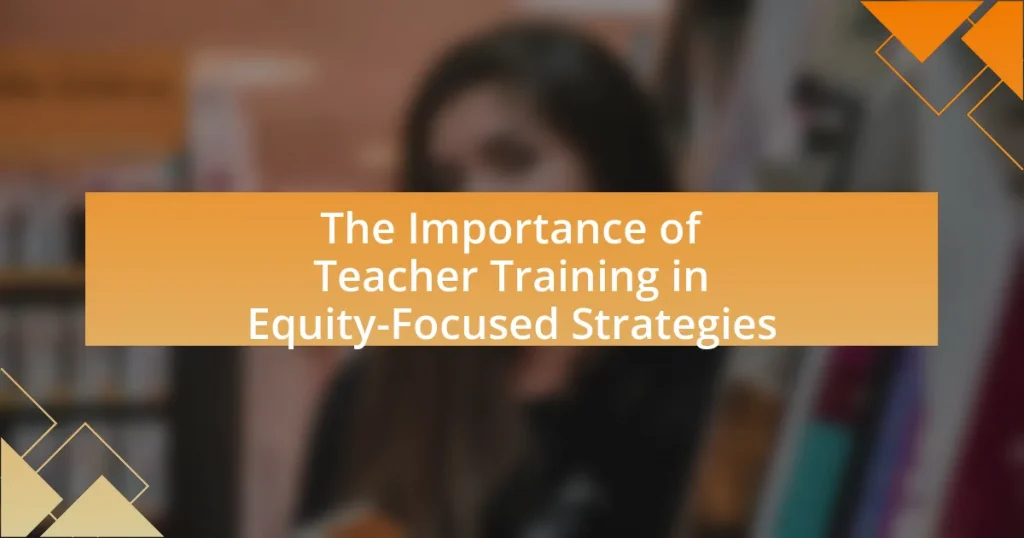The article focuses on the concept of allyship in education, emphasizing the importance of active support and advocacy for marginalized students by educators and peers. It outlines how effective allyship can improve academic outcomes and emotional well-being by creating inclusive environments and amplifying marginalized voices. Key principles of allyship, such as active listening and taking action against injustice, are discussed, along with the distinction between allyship and advocacy. The article also addresses the challenges marginalized students face, the impact of systemic barriers, and practical strategies educators can implement to foster allyship and support these students effectively.

What is Allyship in Education?
Allyship in education refers to the active support and advocacy for marginalized students by educators and peers. This involves recognizing and addressing systemic inequalities, creating inclusive environments, and amplifying the voices of those who are often silenced. Research indicates that effective allyship can lead to improved academic outcomes and emotional well-being for marginalized students, as it fosters a sense of belonging and validation within the educational setting.
How can allyship support marginalized students?
Allyship can support marginalized students by providing them with advocacy, resources, and a safe space to express their identities. When educators actively engage in allyship, they create an inclusive environment that acknowledges and addresses the unique challenges faced by these students. Research indicates that supportive relationships with allies can lead to improved academic performance and mental health outcomes for marginalized students, as they feel validated and empowered. For example, a study published in the Journal of Educational Psychology found that students who perceived their teachers as allies reported higher levels of engagement and lower levels of anxiety. This demonstrates that allyship not only fosters a sense of belonging but also enhances educational experiences for marginalized students.
What are the key principles of effective allyship?
The key principles of effective allyship include active listening, amplifying marginalized voices, and taking action against injustice. Active listening involves understanding the experiences and needs of marginalized individuals without imposing one’s own perspective. Amplifying marginalized voices means ensuring that those who are often silenced are heard and recognized in discussions and decision-making processes. Taking action against injustice requires allies to confront discriminatory practices and advocate for systemic change. These principles are supported by research indicating that effective allyship leads to improved outcomes for marginalized groups, fostering an inclusive environment that benefits all.
How does allyship differ from advocacy?
Allyship differs from advocacy in that allyship involves a personal commitment to support marginalized groups through understanding and solidarity, while advocacy focuses on actively promoting and defending the rights and interests of those groups in public or political arenas. Allyship emphasizes listening, learning, and amplifying voices, whereas advocacy often entails taking direct action, such as lobbying or organizing campaigns. This distinction is crucial in educational contexts, where educators can foster allyship by creating inclusive environments and simultaneously engage in advocacy by addressing systemic inequalities affecting marginalized students.
Why is allyship important for educators?
Allyship is important for educators because it fosters an inclusive environment that supports marginalized students. Educators who actively engage in allyship can help dismantle systemic barriers, promote equity, and create a safe space for all students to thrive. Research indicates that students who feel supported by allies are more likely to succeed academically and socially. For instance, a study published in the Journal of Educational Psychology found that supportive teacher-student relationships significantly enhance student engagement and achievement, particularly among marginalized groups. Thus, allyship not only benefits individual students but also contributes to a more equitable educational system overall.
What impact does allyship have on student outcomes?
Allyship positively impacts student outcomes by fostering an inclusive environment that enhances academic performance and emotional well-being. Research indicates that students who perceive support from allies, such as teachers and peers, experience increased engagement and motivation, leading to higher grades and improved attendance. For instance, a study published in the Journal of Educational Psychology found that students with supportive relationships in school reported better academic achievement and lower levels of stress. This evidence underscores the critical role of allyship in promoting not only academic success but also the overall mental health of marginalized students.
How can allyship foster a more inclusive classroom environment?
Allyship fosters a more inclusive classroom environment by actively supporting and advocating for marginalized students, which enhances their sense of belonging and engagement. When educators and peers practice allyship, they create a culture of respect and understanding, allowing all students to feel valued and heard. Research indicates that inclusive practices, such as promoting diverse perspectives and addressing biases, lead to improved academic outcomes and emotional well-being for marginalized students. For instance, a study by the American Psychological Association found that students who perceive their teachers as allies report higher levels of school connectedness and lower levels of discrimination. This evidence underscores the critical role of allyship in cultivating an inclusive educational atmosphere.

What challenges do marginalized students face in education?
Marginalized students face significant challenges in education, including systemic inequities, lack of access to resources, and social stigma. Systemic inequities manifest in underfunded schools, which often serve marginalized communities, leading to inadequate facilities and fewer educational opportunities. For instance, a report from the National Center for Education Statistics indicates that schools in low-income areas receive about $1,200 less per student than those in wealthier districts. Additionally, marginalized students frequently encounter barriers such as discrimination and bias from peers and educators, which can hinder their academic performance and mental well-being. Research published in the Journal of Educational Psychology shows that students who experience discrimination are more likely to report lower academic achievement and higher dropout rates. These challenges collectively contribute to an educational environment that is often unwelcoming and inequitable for marginalized students.
How do systemic barriers affect marginalized students?
Systemic barriers significantly hinder marginalized students by limiting their access to quality education and resources. These barriers manifest through inequitable funding, discriminatory policies, and inadequate support systems, which collectively contribute to lower academic achievement and higher dropout rates among these students. For instance, research from the National Center for Education Statistics indicates that schools in low-income areas receive substantially less funding than those in affluent neighborhoods, resulting in fewer educational opportunities and resources for marginalized students. This inequity perpetuates a cycle of disadvantage, making it difficult for these students to succeed academically and socially.
What role does socioeconomic status play in educational access?
Socioeconomic status significantly influences educational access by determining the resources available to students and their families. Students from lower socioeconomic backgrounds often face barriers such as inadequate funding for schools, limited access to extracurricular activities, and fewer educational materials, which can hinder their academic performance. Research indicates that children from low-income families are less likely to attend high-quality schools, with a report from the National Center for Education Statistics showing that schools in low-income areas receive substantially less funding than those in affluent neighborhoods. This disparity in funding leads to larger class sizes, fewer qualified teachers, and limited access to advanced coursework, ultimately affecting students’ educational outcomes and opportunities for higher education.
How does cultural bias manifest in educational settings?
Cultural bias manifests in educational settings through curriculum content, teaching practices, and assessment methods that favor dominant cultural perspectives while marginalizing others. For instance, textbooks often reflect the histories and contributions of predominantly white, Western figures, neglecting diverse cultural narratives. Additionally, educators may unconsciously apply different behavioral expectations based on cultural stereotypes, leading to disproportionate disciplinary actions against students from marginalized backgrounds. Research indicates that students who perceive bias in their educational environment are more likely to experience lower academic performance and engagement (Steele, Claude M., “Stereotype Threat and Black College Students,” 1999). This evidence underscores the need for educators to recognize and address cultural biases to create an inclusive learning environment.
What are the emotional and psychological impacts on marginalized students?
Marginalized students often experience significant emotional and psychological impacts, including increased anxiety, depression, and feelings of isolation. Research indicates that these students face systemic barriers and discrimination, which can lead to chronic stress and a diminished sense of belonging. For instance, a study published in the Journal of Educational Psychology found that marginalized students reported higher levels of emotional distress compared to their peers, with 40% indicating feelings of hopelessness. Additionally, the American Psychological Association highlights that these students may struggle with self-esteem issues and identity conflicts, further exacerbating their mental health challenges.
How can feelings of isolation affect student performance?
Feelings of isolation can significantly hinder student performance by negatively impacting their mental health and academic engagement. Research indicates that students who experience social isolation often report higher levels of anxiety and depression, which can lead to decreased motivation and lower academic achievement. For instance, a study published in the Journal of Educational Psychology found that students who felt socially isolated had lower grades and were less likely to participate in classroom activities. This correlation highlights the importance of social connections in fostering a supportive learning environment, as students who feel connected are more likely to engage actively and perform better academically.
What strategies can educators use to address mental health concerns?
Educators can implement strategies such as creating a supportive classroom environment, integrating mental health education into the curriculum, and providing access to mental health resources to address mental health concerns. A supportive classroom environment fosters open communication and trust, allowing students to express their feelings and seek help. Integrating mental health education helps destigmatize mental health issues and equips students with coping strategies. Providing access to mental health resources, such as counseling services or partnerships with mental health organizations, ensures that students receive the necessary support. Research indicates that schools with comprehensive mental health programs see improved student outcomes, including better academic performance and reduced behavioral issues.

How can educators build effective allyship?
Educators can build effective allyship by actively listening to marginalized students and advocating for their needs. This involves creating safe spaces for open dialogue, where students feel comfortable sharing their experiences and challenges. Research indicates that when educators engage in culturally responsive teaching and demonstrate empathy, they foster trust and support among students. For instance, a study by Gay (2010) highlights that culturally relevant pedagogy enhances student engagement and academic success, reinforcing the importance of allyship in educational settings.
What practical steps can educators take to support marginalized students?
Educators can support marginalized students by implementing inclusive teaching practices, such as culturally responsive pedagogy. This approach recognizes and values the diverse cultural backgrounds of students, fostering an environment where all students feel respected and engaged. Research indicates that culturally responsive teaching can improve academic outcomes for marginalized groups by 30% (Gay, 2010). Additionally, educators should provide access to resources and support systems, such as mentorship programs and counseling services, which have been shown to enhance the educational experience and retention rates for marginalized students. By actively promoting equity in classroom discussions and curricula, educators can create a more inclusive learning environment that addresses the unique challenges faced by marginalized students.
How can educators create a safe and welcoming classroom environment?
Educators can create a safe and welcoming classroom environment by establishing clear expectations for behavior and fostering open communication. Setting ground rules promotes respect and inclusivity, while encouraging students to express their thoughts and feelings helps build trust. Research indicates that classrooms with a positive emotional climate enhance student engagement and learning outcomes, as shown in a study by Pianta et al. (2008) in the “Journal of Educational Psychology,” which found that supportive teacher-student interactions significantly improve academic performance. Additionally, incorporating diverse perspectives in the curriculum validates students’ identities and experiences, further contributing to a sense of belonging.
What role does ongoing education and self-reflection play in allyship?
Ongoing education and self-reflection are essential components of effective allyship, as they enable individuals to understand systemic inequalities and their own biases. Continuous learning about social justice issues equips allies with the knowledge necessary to advocate for marginalized communities effectively. For instance, research by the American Psychological Association highlights that self-reflection allows individuals to recognize their privilege and biases, fostering a deeper empathy towards those they aim to support. This process not only enhances awareness but also informs actions that align with the needs of marginalized groups, ultimately leading to more impactful allyship.
How can collaboration enhance allyship efforts?
Collaboration enhances allyship efforts by fostering a shared understanding and collective action among individuals and groups. When educators, students, and community members work together, they can identify specific needs and challenges faced by marginalized students, leading to more effective support strategies. Research indicates that collaborative approaches, such as co-designing programs and initiatives, result in increased engagement and empowerment of marginalized voices, which is crucial for authentic allyship. For example, a study by the National Education Association found that schools implementing collaborative practices saw a 30% increase in student participation in support programs, demonstrating the tangible benefits of working together to advocate for equity and inclusion.
What partnerships can educators form to support marginalized students?
Educators can form partnerships with community organizations, local businesses, and advocacy groups to support marginalized students. Collaborating with community organizations, such as youth programs and cultural centers, provides resources and mentorship opportunities tailored to the needs of these students. Partnering with local businesses can facilitate internships and job training programs, enhancing students’ real-world skills and experiences. Additionally, working with advocacy groups can help educators stay informed about the specific challenges faced by marginalized communities, allowing for more effective support strategies. These partnerships have been shown to improve educational outcomes and foster a more inclusive environment for all students.
How can community involvement strengthen allyship initiatives?
Community involvement can strengthen allyship initiatives by fostering collaboration and shared understanding among diverse groups. When community members actively participate in allyship efforts, they create a supportive network that amplifies marginalized voices and addresses systemic inequalities. Research indicates that inclusive community engagement leads to more effective advocacy, as seen in initiatives like the “Community Organizing for Social Change” model, which emphasizes collective action and empowerment. This model demonstrates that when individuals from various backgrounds unite, they can challenge discrimination and promote social justice more effectively.
What are some best practices for sustaining allyship in education?
Best practices for sustaining allyship in education include ongoing education, active listening, and creating inclusive environments. Educators should engage in continuous professional development focused on diversity, equity, and inclusion to better understand the experiences of marginalized students. Active listening involves valuing student voices and incorporating their feedback into decision-making processes. Additionally, fostering inclusive environments requires implementing policies that promote equity and ensuring that all students feel safe and supported. Research indicates that schools with strong allyship practices see improved student engagement and academic outcomes, highlighting the effectiveness of these strategies in supporting marginalized communities.
How can educators measure the effectiveness of their allyship efforts?
Educators can measure the effectiveness of their allyship efforts through surveys and feedback from marginalized students. By collecting qualitative and quantitative data on students’ experiences and perceptions, educators can assess the impact of their actions. For instance, a study by the American Educational Research Association found that student feedback significantly correlates with perceived support and inclusivity in educational environments. Additionally, tracking changes in student engagement, academic performance, and retention rates can provide concrete evidence of the effectiveness of allyship initiatives.
What resources are available for educators to improve their allyship skills?
Educators can improve their allyship skills through various resources, including professional development workshops, online courses, and literature focused on diversity and inclusion. For instance, organizations like Teaching Tolerance offer free resources and training modules that help educators understand systemic inequities and develop strategies for supporting marginalized students. Additionally, books such as “Culturally Responsive Teaching and The Brain” by Zaretta Hammond provide insights into effective teaching practices that promote equity. Research indicates that ongoing education in these areas significantly enhances educators’ ability to foster inclusive environments, as highlighted in studies published by the American Educational Research Association.
What are the key takeaways for educators looking to build allyship?
Educators looking to build allyship should prioritize active listening, understanding diverse perspectives, and advocating for marginalized students. Active listening fosters trust and allows educators to grasp the unique challenges faced by these students. Understanding diverse perspectives involves engaging with the cultural backgrounds and experiences of students, which can enhance empathy and support. Advocating for marginalized students includes implementing inclusive practices and policies that address systemic inequities in education. Research indicates that schools with strong allyship programs see improved student engagement and academic outcomes, highlighting the effectiveness of these strategies in creating supportive learning environments.



